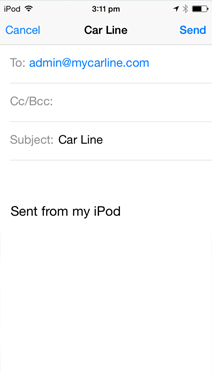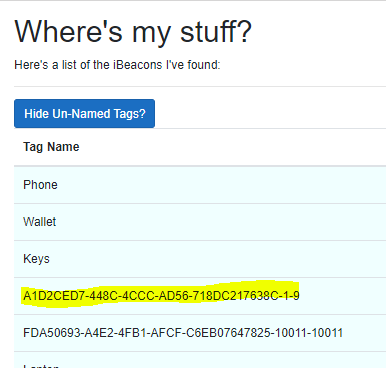
- BEACON UUID GENERATOR INSTALL
- BEACON UUID GENERATOR UPDATE
- BEACON UUID GENERATOR ANDROID
- BEACON UUID GENERATOR PASSWORD
- BEACON UUID GENERATOR BLUETOOTH
The BlueZ libraries provide support for the core Bluetooth layers and protocols.
BEACON UUID GENERATOR INSTALL
Step 7: Download, Make, & Install BlueZ Library Sudo apt-get install libglib2.0-dev -fix-missing Install the following libraries: sudo apt-get install libusb-dev There are a number of open source libraries and tools used in order to send the iBeacon data from the Raspberry Pi. At this point I typically start connecting using SSH. If you then run ifconfig you should see you now have an IP address. If you’re connected over Ethernet you’ll likely want to restart with sudo shutdown -r now but if you’re using your Console Cable you can simply restart the networking with sudo /etc/init.d/networking restart.
BEACON UUID GENERATOR PASSWORD
auto loīe sure to set your own ssid and password values (and yes, capitalization matters).
BEACON UUID GENERATOR UPDATE
Run sudo nano /etc/network/interfaces (or whatever editor you want to use) and update accordingly.

You’ll need to update your interfaces so that your WiFi connects to your wireless router. I use the Miniature WifFi (802.11b/g/n) Module. When you have a lot of devices this is particularly important. While not absolutely necessary, I always setup WiFi on my Raspberry Pi so that it doesn’t require Ethernet or a console cable for me to connect via SSH. Reboot the Raspberry Pi ( sudo shutdown -r now) and reconnect. It’s likely enabled already but you may as well make sure. Choose Advanced Options then A2 Hostname.Choose Internationalisation Options then I2 Change Timezone.I removed the existing setting and chose enUS.UTF-8 UTF-8. Choose Internationalisation Options then I1 Change Locale.Run sudo raspi-config and complete the following six steps. Once you connect to the device you should first configure a few settings. It’s worth noting that your default user name is pi and password is raspberry. I personally like to use the Console Cable to connect directly from my Mac but you can also connect with Ethernet & SSH or connect a monitor and keyboard. Step 3: Connect to the Raspberry PiĪgain, you have numerous options for connecting to the device. If you’re using a Mac I recommend Ray Viljoen’s Raspberry PI SD Installer OS X script. There are numerous tutorials available for this step. The steps below work on the release.ĭownload the image from the official downloads page: Step 2: Write the Image to the SD Card I chose to use the Raspbian Debian Wheezy image. There are numerous OS images you can use with the Raspberry Pi. Step 1: Download an Operating System Image If you follow these instructions with the above hardware I’m reasonably confident you can get this up and running with no problems. Here are the steps I’ve taken to, repeatedly, get Raspberry Pi’s setup as iBeacon transmitters. Additionally, I think some of the tutorials are simply wrong or poorly document the process. As so often happens when you’re on the bleeding edge, things change and instructions stagnate. Yes, there are a lot of tutorials, but sadly none worked perfectly for me. Over the past week I’ve had to setup and configure numerous Raspberry Pi’s as iBeacons. Setup the Raspberry Pi as an iBeacon Transmitter The WiFi and Pi Case are optional but I strongly encourage you to get them. Miniature WiFi (802.11b/g/n) Module (optional).Bluetooth 4.0 USB Module (v2.1 Back-Compatible).You don’t have to purchase from Adafruit, but to have the best results I’d recommend you try to get the same hardware I used otherwise your mileage may vary. In this post we’re going to look at how you can start to play around with this using that universal toy for the hacker: the Raspberry Pi. The point is, this is cool technology with a lot of different applications and uses. If you look around the Internet you’ll find hundreds of additional use cases and ideas. Simply tag your bag with a BLE transmitter and then, if it leaves the proximity/region, get alerted! Alert you while you sit at a bar enjoying your favorite craft beer when someone rides off with your bicycle outside.Customize retail offers based on your location in a store and proximity to certain products.Host a digital scavenger hunt by placing iBeacons with different clues scattered around a conference.Why would you want to do this? Well, if the act of configuring a Raspberry Pi itself isn’t enough of a reward, consider some of the following use cases:
BEACON UUID GENERATOR ANDROID
Android devices can receive iBeacon advertisements and, fortunately for those of us who like to hack around, it doesn’t take too much work to setup a Raspberry Pi to emit iBeacon advertisements. It uses Bluetooth Low Energy (BLE), also called Bluetooth Smart, technology to transmit an advertisement that includes a universally unique identifier (UUID).

IBeacon is the Apple trademark for a low-powered, low-cost transmitter that can notify nearby iOS 7 devices of its presence.


 0 kommentar(er)
0 kommentar(er)
